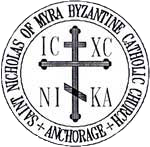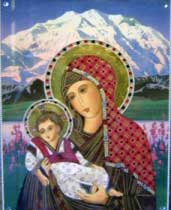 |
| The First Byzantine Catholic Parish Canonically Established on the West Coast of the USA! 2200 Arctic Blvd., Anchorage AK 99503-1909 Ph: 907 277-6731 |
|
 |
HELPFUL HINTS FOR PARTICIPATING IN OUR LITURGY We celebrate the Divine Liturgy according to our Ruthenian Traditions of the Byzantine Rite. Faithful to the tradition of using the vernacular, our Liturgy is celebrated in English, with Old Slavonic, Greek or Spanish used for some responses or hymns during Lent and Pascha (Easter). The Liturgy has recognizable parts—Scripture Reading, the Anaphora (Eucharistic Prayer), and Holy Communion—but the ceremonies surrounding them are different. Our worship experience is what could be called a holistic approach in which all the senses are engaged to encounter joyfully the risen Christ among us in all His glory. The following comments may be helpful for you to participate in the Liturgy. The Church: Entering our church is a mystical experience where you are swept off your feet so that you know you are in God’s presence. We are called to put aside all earthy cares so that we may encounter God in all His glory. The Iconostas: This is a wall with icons and doors that separates the nave (earth) of the church from the Holy of Holies (heaven) where the clergy celebrate the Divine Mysteries. The icons (religious paintings) represent Christ, the Mother of God and all the saints call us to prayer and reflection so we can encounter God on earth and have a foretaste of heaven in this earthly life. During Liturgy the Angelic Doors (center doors) are opened so that we have a glimpse of the heavenly worship. Holy Table: Beyond the iconostas is the Holy Place where God is found presence in His Word in the ornate Gospel Book resting on the altar and in the Holy Eucharist in the tabernacle. Bowing: According to our ancient traditions, we bow as a sign of reverence to God. We bow our heads and shoulders and make the sign of the cross upon entering and leaving the church. We also bow during the Liturgy and bless ourselves whenever the priest blesses us or the Persons of the Trinity are mentioned. Standing: We stand in church on Sundays in celebration of the Resurrection and also on great holydays to acknowledge that Christ has redeemed and saved us by His Blood. We acknowledge and accept this salvation by standing as freed men and women in His presence. Hence it is contrary to our Tradition to kneel on Sundays and from Pascha to Pentecost Sunday evening. During the consecration and the invocation of the Holy Spirit, we make a profound bow—a bow at the waist—as a sign of reverence. Chanting: The entire Liturgy is chanted as a sign of our joyfulness in God’s presence. Altar Bread: Our altar bread is made with yeast and therefore has a thickness to it. Before Liturgy, the priest cuts a loaf of specially baked altar bread into cubed particles that will be consecrated and distributed for Holy Communion. Holy Communion: Only baptized Catholics and Orthodox faithful who are in the state of grace and in good standing within their respective Churches may partake of Holy Mysteries. Holy Communion is given in the following manner: the consecrated particles are placed into the chalice before Communion. The priest places a small particle on a golden spoon to give you Holy Communion. If you wish to receive Holy Communion, come forward to the priest and quietly state your first name if he does not know your name. Then open your mouth wide, tilt your head back slightly, and keep your tongue inside your mouth. The priest will bring the spoon to your mouth and gently place the Eucharist into it. Wait for the priest to move his hand with the spoon away from your face before you close your mouth and return to your place. If you do this properly the priest will be able to give you Holy Communion without touching any part of your mouth with the spoon. As he gives you Holy Communion the priest will say a prayer to which you do not answer “amen”! Holy Anointing: On certain major holydays, the priest will anoint the congregation with holy oil as a sign of our joy in celebrating that feast. Unconsecrated bread is distributed, and an offering for the poor or a special need is made as a sign of our concern for the needs of all. All are invited for this anointing. |
A Catholic Church Serving the Christian Faithful in the State of Alaska According to the Traditions of the Byzantine Catholic Church in Communion with the Bishop of Rome |
|
